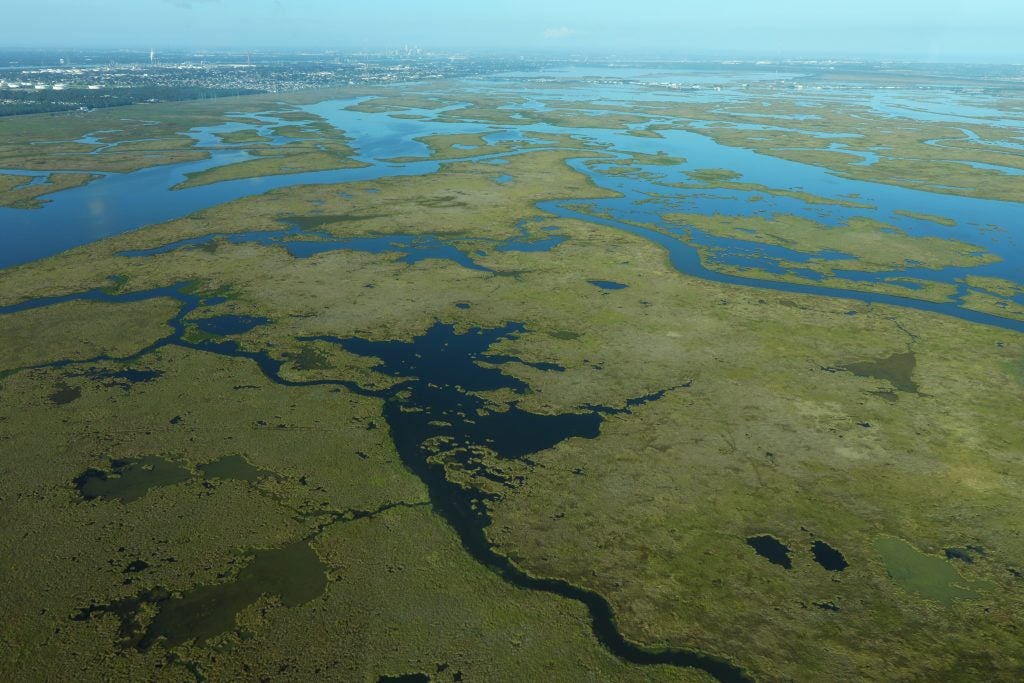
Louisiana has lost 2,000 square miles of coastal wetlands in less than a century, threatening communities from sea level rise and more intense hurricanes. Photo: Leslie Von Pless, EDF
Louisiana represents the paradox of a modern state shaped by a history of fossil fuel-supported development and structural racism that is now dealing with the climate-driven and social impacts of those choices.
As it attempts to do so, it has become a center of climate adaptation and resilience practices, and more recently, climate mitigation efforts, while seeking the right balance for its people, economy and environment.
The results so far look like this:
- Investing billions in coastal restoration and protection projects.
Between land loss from poor management and increasing sea level rise, Louisiana has lost around 2,000 square miles of coastal marshes since 1930 and could lose at least that much more without action. Demonstrating the power of climate change, the 2020 hurricane season alone hit the Louisiana coast with five named storms, including three major hurricanes.
In response to Hurricanes Katrina and Rita in 2005, the state developed Louisiana’s Coastal Master Plan, which employs world-class science to support a mix of large-scale coastal restoration and protection projects to address land loss and provide risk reduction to coastal communities.
On the restoration side, the state has deployed billions of dollars from a range of funding sources to rebuild Louisiana’s barrier islands as a first line of defense from storms and sea level rise; to build living oyster reefs to slow erosion and reduce land loss; to recreate lost wetlands using material dredged from the channel of the Mississippi River; and most importantly, to build sediment diversions that will use the natural land-building power of the river to restore and sustain coastal wetlands over time.
Since developing its first Coastal Master Plan in 2007, the state has used 157 million cubic yards of sediment to create and nourish nearly 50,000 acres of land across its coast, including more than 60 miles of barrier islands.
The work is ongoing. This year the Louisiana Legislature unanimously approved the annual coastal plan funding for the next three years, setting the stage for average annual expenditures of just under $1 billion.
- Resilience grants help communities withstand rising flood waters.
But climate change doesn’t just impact the coast. In addition to coastal flooding, Louisiana has also experienced increases in extreme rainfall causing flooding along rivers, streams and within its towns and cities.
For example, in 2016, the state experienced massive flooding in the Baton Rouge area after days of excessive rainfall. Climate change has made these events 40% more likely and 10% more intense.
In response to this and other flooding events, Louisiana developed the Watershed Initiative to mitigate flood risk through a coordinated effort across agencies and regions. This approach recognizes that flood waters do not adhere to political or geographic boundaries, so stakeholders should work together to reduce flooding at the watershed level.
As a result, Louisiana is committing $1.2 billion in federal grants to projects that reduce flood risk across the state. This includes $100 million for home elevations and voluntary buyouts in some of the more vulnerable parts of the state.
- Louisiana moves to limit its own emissions to curb sea level rise.
In addition to climate adaptation efforts underway, Louisiana has made – some would say surprisingly — a commitment on the climate mitigation side as well. After all, the future existence of many Louisiana coastal communities directly depends on limiting rates of sea level rise to the greatest extent possible. This effort will require the world to be successful in reducing global emissions, and Louisiana is now trying to do its part.
In 2020, Louisiana Gov. John Bel Edwards committed to reducing the state’s net Greenhouse Gas (GHG) emissions to zero by 2050, with stepwise reductions along the way. He established the Climate Initiative Task Force to provide recommendations in early 2022 for achieving these goals.
The task force, comprised of scientists, public officials, community, nonprofit and industry leaders, is currently completing the GHG inventory for the state, while developing the recommendations.
Notable within the structure of this effort is the establishment of an advisory committee, along with legal, finance and science, on Environmental Equity. Its charge will be to make recommendations and assessments around each policy approach using an environmental equity lens. This has the potential to join policy and equity in ways that have seldom occurred in Louisiana, making these climate-based discussions historic in more ways than one!
Climate change is already taking a massive toll on nearly every corner of the state. Louisiana has had emergency flood disasters declared in every parish at least twice over the last 20 years. But Louisiana is fighting back.
Since the creation of its first Coastal Master Plan nearly 15 years ago, Louisiana has become a model for climate adaptation and coastal restoration. Now it is taking on the challenge of trying to show how a traditionally energy-dependent state can reduce emissions and lead on mitigation as well.
These are bold steps. But bold steps are what it will take for all of us to manage in the climate change-driven world in which we now live. It is great to see Louisiana stepping forward and leading.









